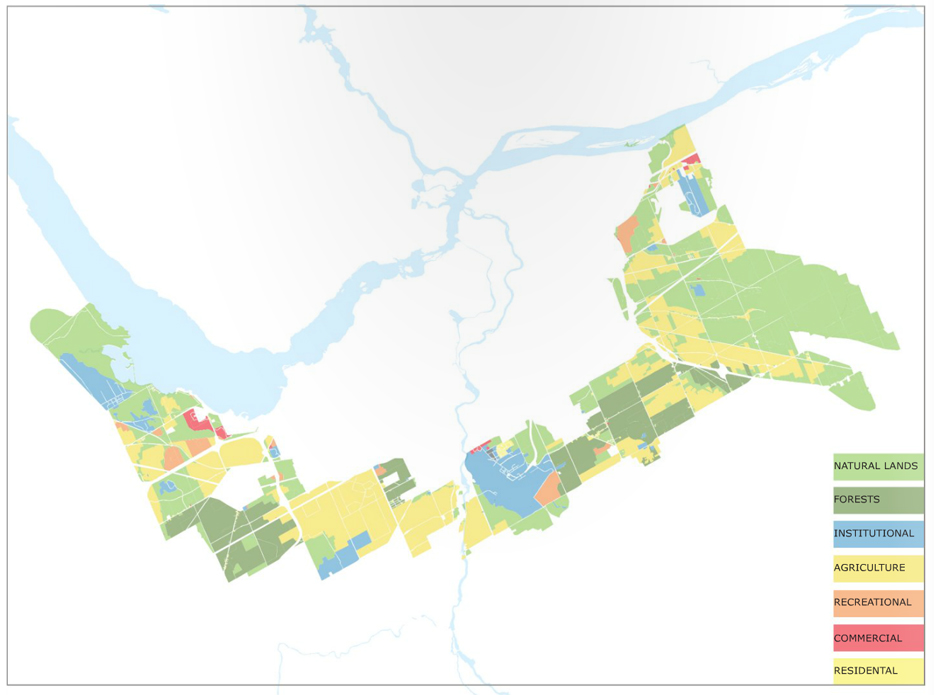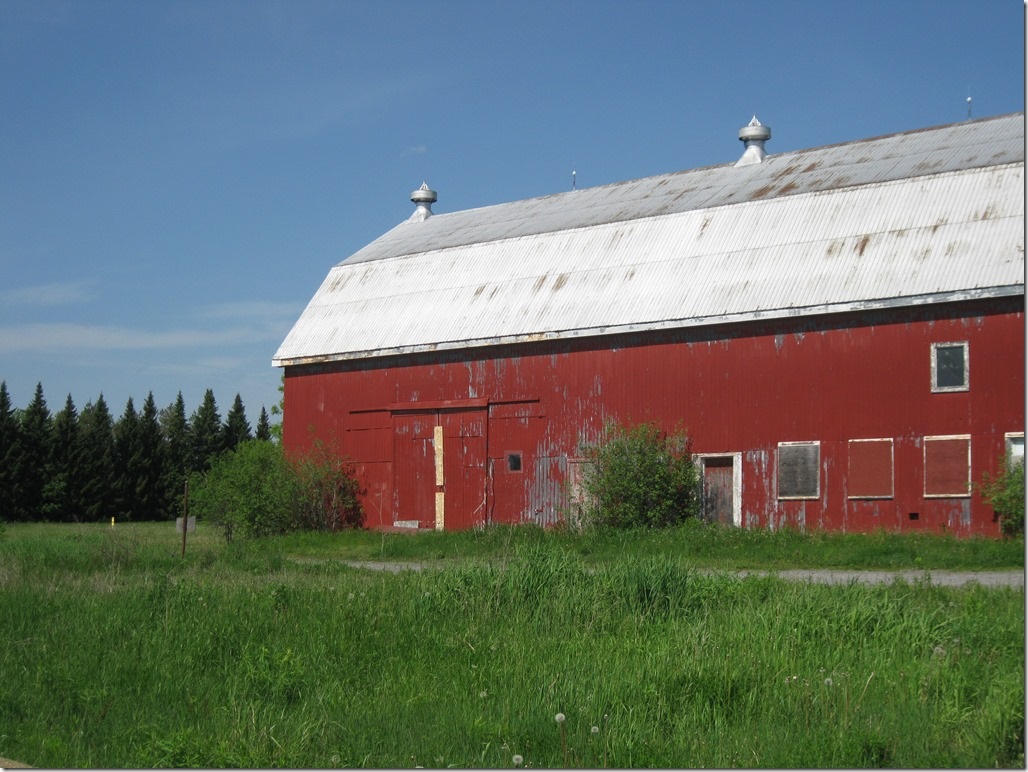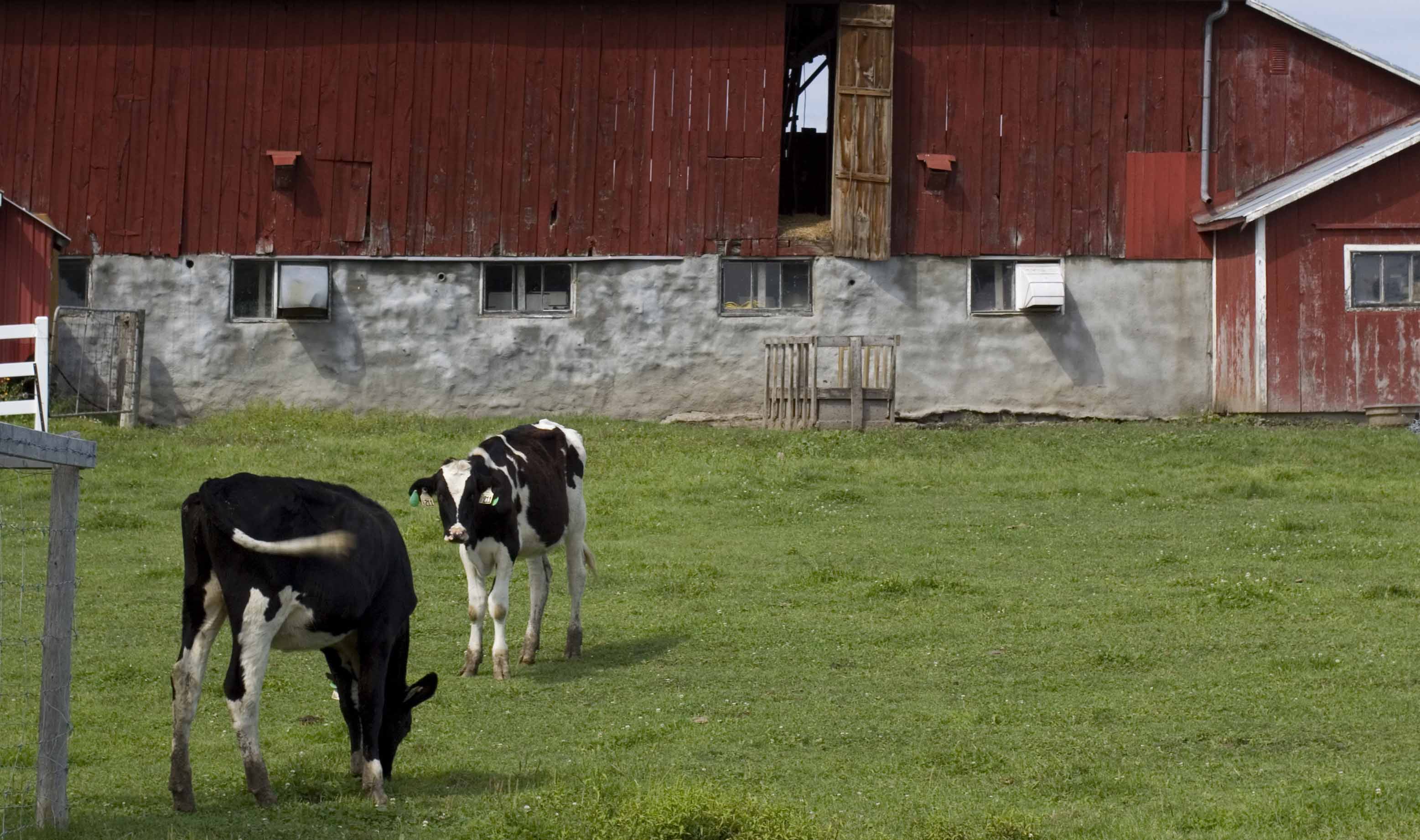Case Study prepared by Jana Nitschke, Carleton University
The Sustainability of Urban Agricultural Heritage Landscape
National Capital Greenbelt, Ottawa, Ontario
KEYWORDS cultural landscape, sustainable agriculture, farmland protection
LESSON LEARNED This case study’s purpose is to evaluate and analyze the current agricultural situation in the Greenbelt of Ottawa to determine positive results that have developed in time to be used for future projects. The Ottawa Greenbelt is unique for being entirely managed by the National Capital Commission and private owners, which manage 5000 hectares of farmland and 56 farmers who produce a variety of agricultural goods important to the city. The NCC supports sustainable agriculture in the Greenbelt. Regulations such as the Greenbelt Master plan control the use of agricultural land, which provide a more sustainable agricultural environment. Greenbelt farm produce a diversity of products, such as milk, meat, grains, fruits and vegetable. These products contribute to the food supply and economy of Canada’s Capital Region. This involves the contribution by local people and measurements to educate them about the heritage value from the greenbelt. The purpose of this project is to educate people about the cultural heritage values of agriculture within the Greenbelt area and means to enhance the agricultural sector for future greenbelts.
DESCRIPTION
National Capital Greenbelt, Ottawa, Ontario, Canada
The National Capital Greenbelt is made up of 20,000 hectares of green space owned by the NCC, which is a federal Crown corporation. The National Capital Act obliges the NCC to improve, develop, and conserve the National Capital for the benefit of all Canadians, to communicate Canada to Canadians, and to promote the Capital as a meeting place for Canadians. Most of the Greenbelt is managed by the NCC, the rest is held by other federal departments and private owners such as Agriculture Canada and private Agricultural Tenants. The Greenbelt is a crescent-shaped patchwork of farms, fields, forests, and research complexes bordering the City of Ottawa and parts of Nepean and Gloucester. It is a unique mosaic of adjoining lands which serve a variety of functions. Paramount among these uses are the recreational trail and core natural area components which enhance the region’s livability. In 1950 it was conceived by Parisian architect-planner Jacques Greber as a means to shape the expanding urban Capital and to provide a reserve of land for future public and private institutions. In 1961, the National Capital Commission (NCC) entered into a 50-year forest management agreement with the Government of Ontario, and much of the Greenbelt’s abandoned and the marginal farmland has since been reforested. Today, one third of NCC-owned lands are leased to tenants for a variety of uses ranging from farms to municipally run recreation facilities, and approximately 8,000 people work and 1,000 people live in the Greenbelt.
TIMELINE
- 1950 Proposal created by Parisian architect-planner Jacques Greber to shape the expanding urban Capital and to provide a reserve of land for future public and private institutions.
- 1956 establishment of the Greenbelt area
- 1959 the NCC was created by Parliament
- 1961 50-year forest management agreement with the Government of Ontario
- 1990 600-person public opinion survey to gauge public awareness and opinion of the Greenbelt within the National Capital Region (NCR)
- 1991 150 students at nine Canadian university schools of urban and regional planning developed master plans for the Greenbelt
- 1995 Greenbelt Master Plan
- 1999 Plan for Canada’s Capital Region
- 2013 Canada’s Capital Greenbelt Masterplan
- 2067 Future plan for Canada’s Capital, 200th Anniversary of Confederation
STAKEHOLDERS
- NCC, National Capital Commission
- Greenbelt land management and lease
- AAFC, Agriculture and Agri-Food Canada
- City of Ottawa Recreation and Community Services Department
- City of Ottawa
- CanmetENERGY, Natural Resources Canada
- Agricultural Tenants
- Greenbelt Farm Tenants Association
- Canadian Organic Growers
NATURAL/CULTURAL HERITAGE Natural and Cultural heritage values are a key attribute to the Ottawa Greenbelt. The NCC places an interest in preserving the heritage aspects of the past for future generations. Within the Greenbelt, cultural heritage includes a mix of built structures such as the lime kiln, The Rideau Canal and Carlsbad Springs, but also includes farmsteads, heritage forests and natural features such as Shirley’s Bay, Stony Swamp and Green’s creek, to mention only a few.
The Greenbelt plays an important part in our sense of national identify and the enjoyment of the Capital Region. Cultural Landscape reflects human history and captures the relationship between humans and the environment and is defined by the NCC “a set of ideas and practices, embedded in a place”. The land cover within the Greenbelt comprises mainly forests, wetlands and fields with mixed use for recreation, conservation, farming, research, and forestry uses. Outdoor activities such as hiking, biking, cross-country skiing and snowshoeing are very popular among the Ottawa community. Each year approximately 3.5 million people visit the Greenbelt. Over 150 kilometres of trails are dedicated to recreational use in the Greenbelt. Currently the Greenbelt has three recreational paths that are excellent for cycling, walking and running. They are:
- Watts Creek Pathway
- Greenbelt Pathway West
- Greenbelt Pathway East
Within the Niagara Escarpment, the Oak Ridges Moraine and the Carolinian life zone, forests, grasslands, wetlands and rivers support a rich diversity of life forms, right on the doorstep of many urban dwellers. Another land use that is important in our sense of national identity is agriculture. 5000 Hectares of farmland are incorporated within the Greenbelt and provide 56 working farms with land. In 2004 the NCC published a study about Cultural Landscapes Heritage Values and describes agriculture lands as evolved cultural landscapes. Evolved cultural landscapes result from a more general idea, not necessarily specific to a particular individual, group or time period, that evolves over time, in some cases over many centuries, integrating changes introduced by new ways of seeing and using space. These ideas are usually related to assumptions fundamental to social and economic life, such as agricultural or mercantile practices and their evolution over time. The cultural assumptions that support these ideas are widely shared and allow a cultural landscape to evolve through multiple contributions. The Greenbelt was created, not by single designers, but by a number of individual actors who adapted traditional cultural practices and related land use patterns in their new environment. These landscapes have a dynamic quality that will not challenge their integrity as long as the underlying ideas and associated practices remain intact.
Through leasing arrangements, farmland is available and secured for young farmers at rental rates that reflect the agricultural potential of the land. However farmland is threatened by the decrease of young educated farmers interested in the field. As farmland and farmers are lost, the character and heritage values of an area are permanently changed. The preservation of this scenic landscape and cultural heritage is bound to the preservation and enhancement of the Greenbelts agricultural resources of farms being saved by current farmers and the next generations.
Generally there is a goal of protecting the heritage value of farmlands by focusing on the historic buildings to remain the traditional rual character of the region. One example is the Log Farm, a historic site and a living museum of an 1850s pioneer homestead. Sustaining these structures is in the interest of the NCC, however challenging in the long run for more active farms because farmers would like to modernize their operations, which can require adding or replacing certain structures. Modernization is in the interest of farmers to make them more economically viable which would also insure their existence in the Greenbelt. Sometimes certain regulations will prohibit farmers to make such changes to their land to retain the heritage and aesthetic value of these buildings. A main problem is that communication between landowners or leasers and the NCC on who is responsible to decide which changes are made and who will cover these costs.
Nonetheless Farms are economically profitable, and even more so when combined with Agritourism. Agricultural tourism has the potential to enhance farm incomes, provide education opportunities and create linkages between city residents and the Greenbelt. Some of the recreational and educational activities are for example tours and visits of the farms. Fun activities for families or school classes are to learn about the lifecycle of bees, observing farm animals up close and learning where groceries come from. It also gives farmers the opportunity to directly sell their local products to the buyer and develop a market.
Some rare fruits and vegetables might be saved from extinction through these one on one sales, because they are usually to fragile to be shipped to bigger food distributions such as grocery stores or are to time consuming to grow. However local buyers are more favorable to buy unknown types of vegetation’s when they are local. Overall the cultural heritage within agriculture is one that gets often overseen and ignored.
FUTURE VISION The Greenbelt Master plan’s (2013) goal set for the future year of 2067 is to engage passionate people with the knowledge needed to increase farm diversification, visibility and the contribution of Greenbelt agriculture to local food, and agricultural experiences, resulting in greater relevance for the community. This shows the significance of cultural heritage in agriculture of the Greenbelt and to be able to achieve this goal, sustainability measurements must be taken.
SUSTAINABILITY The Greenbelt’s grasslands, woodlands, wetlands and waterways underpin many major economic activities, such as forestry, agriculture and tourism. Sustainable Agriculture integrates environmental health, economic profitability and social equity. Greenbelt farms demonstrate these themes and therefore need guidelines for sufficient sustainable plans. These plans are regulated by the NCC [i]and are in the Master Plan, which has developed in the years and was updated in 2013. According to the plan, agriculture sustainability is the second role focused on which includes local food distribution and community gardens but also diversified farming. According to agricultural census data, the number of farms and farm hectares in the National Capital Region is decreasing. The loss of farms and farmland can cause a serious impact on economy, environment and quality of life for the people in Ottawa. Greater awareness has the potential to increase market opportunities and related economic stability for the farm sector. This is a critical component of sustainability.
Environmental sustainability
Due to economic and political pressures, the agricultural industry has also become a major cause of environmental degradation, as farmers have been forced to use modes of production that are unsustainable in the long term. Industrial agriculture is dependent on the maximization of output, meaning an increased need for petrochemical-based inputs, such as fertilizers and pesticides, as well as monoculture crops and destructive soil management practices. However there is an increased of interest in organic food production and consumption that changes the farmers industry. JustFood is a webbased community that encourages local and organic food distribution and promotes different projects such as the Community Shared Agriculture (CSA) Farming[ii]. According to the 2006 Census of Agriculture, more farmers are reporting using soil conservation practices and no till practices are becoming more popular as they reduce input costs and soil erosion from wind and water. Generally, farmers are also using less fertilizer and pesticides on a per acre basis.
Socio-economic sustainability
Agriculture is increasingly becoming a globalized, commodity driven industry. Global and local economic, environmental and societal trends can have large impacts on the whole industry. At the same time there is a new trend towards alternative farming, which is challenging current notions of agriculture in the 21st century, and these new trends are also important to consider both globally and locally. In an export-oriented country, farms are becoming bigger in order to compete on the global market, and those that are unable to compete are squeezed out. In the Master plan, prohibit activities and uses of land use are large livestock operations of over 200 animal units and production that has recognized negative impacts on soil and water. Because of these regulations, many Greenbelt farmers are forced to make a living by also providing off-farm income.
Socio-cultural sustainability
Environmentally friendly farm practices such as organic and biodynamic as well as promoting expansion into the domestic markets are strategies that encompass interlock the components of economy, environment, culture and society. This action will allow farmers to tap into the growing consumer demand for sustainable, local, and place-based foods. As concerns about the environmental impacts of conventional farming grow, the demand for alternatives is growing, and consumers are often willing to pay a premium for these products. There is an important opportunity to encourage the development and increased profile of this form of agriculture side by side with more traditional farms. Moreover, small productive operations do have the opportunity to be economically viable.
The Master Plan sets a long-term aim to achieve viable and sustainable agriculture on the farmsteads and agricultural research facilities within the Greenbelt. Environmental stewardship and implementation of best management practices forms part of the policy directions for Greenbelt agriculture. In summation the Greenbelt can be a window into a modern, sustainable and viable farm sector that is rooted within the cultural and historical legacy of Canada’s past.
MEASUREMENT
The Greenbelt Master plan (2013) is the main document for any regulation within the Greenbelt and addresses issues and provides project consultations. The following is a list published by the NCC in the Greenbelt Master Plan Review Phase 2 – Step D and shows the main supporting policies and strategies for Agriculture within the Greenbelt:
- Maintain or establish conditions for farms to be more economically, environmentally, and socially viable.
- Encourage the desired types of farm and agricultural practices:
- Promote farm best management practices to conserve soil and water resources and promote biodiversity while ensuring farm productivity and viability.
- Apply a tenant selection process to identify farm candidates able to deliver sustainable and locally relevant agriculture.
- Create new small farm sites using adjoining houses and selected land parcels within the Greenbelt.
- Facilitate value‐added activities on Greenbelt farms and establishment of more organic farms and community gardens.
- Protect and expand farm assets and built infrastructure:
- Revise farm leases in order to promote long term sustainable farm development
- Preserve and improve selected heritage farmsteads for modern farm use and permit integration of new farm buildings where a need for an updated facility is identified.
- Direct agricultural activities that do not require high capability soils for food production to locate on lower capability soils..
- Enhance visibility of the Greenbelt farm sector and help visitors appreciate the region’s farming culture and rural heritage.
- Engage Greenbelt farmers and build effective partnerships to achieve the above.
The NCC provides guidance for the definition and assessment of cultural landscapes for the Greenbelt. The report was made available in digital format to facilitate its continuum as a living document in 2004.
SOURCES
Documents
- Caldwell, W., Temple, Katie. Farm National Capital Commission. (2009). Canada’s Capital Greenbelt: Moving towards Sustainable Agriculture.
- National Capital Commission. Long Range Planning Division. (1991). Future greenbelt: Agricultural analysis.
- Julian Smith & Associates Contentworks inc. for: the Design and Land Use Devision, Capital Planning and Real Asset Management Branch (2004). Definition and Assessment of Cultural Landscapes of Heritage Value on NCC Lands. National Capital Commission
- National Capital Commission. Environmental Assessment: Making Better Decisions.
- SENES Consultants Limited, & Canadian Electronic Library (Firm). (2013). Canada’s capital greenbelt master plan. Beaconsfield, Quebec: Canadian Electronic Library.
- SENES Consultants Limited, National Capital Commission. (2013). Greenbelt Master Plan Review, Phase 2 – Step D Land Designations, Policies and Sector Plans. Beaconsfield, Quebec: Canadian Electronic Library.
- SENES Consultants Limited, National Capital Commission. (2013). Greenbelt Master Plan Review, Strategic Environmental Assessment. Beaconsfield, Quebec: Canadian Electronic Library.
Websites
Just Food
- Working for a Sustainable and Just Food system in Ottawa. (2014, January 1). Retrieved November 23, 2014, from http://www.justfood.ca/
NCC, National Capital Comission
- (n.d.). Retrieved November 23, 2014, from http://www.ncc-ccn.gc.ca/places-to-visit/greenbelt/about-national-capital-greenbelt
Realontario
- The Old Log Farm. (2008, January 1). Retrieved November 23, 2014, from http://www.realontario.ca/index.php/ontario-tourism-listing?pid=8691
OFA, Ontario Federation of Agriculture
- Ottawa Federation of Agriculture | News. (n.d.). Retrieved November 23, 2014, from http://www.ofa.on.ca/about/county-federation-sites/ottawa/news/A-united-front-for farmland-preservation
Ontario Farmland Trust
- Provincial Policy Statement. (n.d.). Retrieved November 23, 2014, from http://ontariofarmlandtrust.ca/programs/policy/pps/
[i] See the Measurement section for examples of policies and strategies used by the NCC for agricultural sustainability.
[ii] See justfood.ca for further information about current projects and organic food supplies in farmers markets or other distributors.




